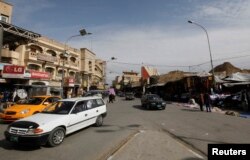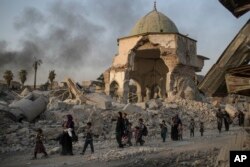*This report originated in VOA's Kurdish service.
MOSUL, IRAQ — Walid Dabagh travels across the ruins of Mosul, hunting for traces of the Islamic State's reign of terror.
Once he finds it, Dabagh replaces the violent graffiti of the group with beautiful paintings recounting life in Mosul's Old City before it was reduced to rubble in a brutal war.
"I want to revive memories of all this lost heritage," he told VOA. "I want the new generation to know what the Old City was like."
Mosul was Iraq's second-largest city and home to more than 1 million people before Islamic State occupied it in mid-2014.
Years of brutal IS rule and the subsequent Iraqi battle to oust the terror group have left thousands dead and reduced much of the city's western side to rubble. The United Nations estimates that 40,000 homes in the city need to be rebuilt or restored.
The Old City, where Dabagh takes most of his artistic inspiration from, used to be a densely populated district and Mosul's liveliest area before IS took control. It is now an open field of shattered concrete and twisted metal left from houses and shops destroyed by nine months of war to expel the terror group from the city.
Unlike IS, which destroyed all places of worship that it deemed un-Islamic, Dabagh's murals show mosques and churches standing side by side. His work attempts to show the diversity and sense of coexistence that prevailed in the city.
Hope for restoration
Dabagh said Mosul residents were hoping that the Old City would be restored and displaced civilians could return soon after IS militants were ousted in July 2017. But he said those hopes were waning because of a protracted reconstruction process by the Iraqi government.
Dabagh's greatest concern is that the Old City's historical treasures could vanish and the younger generation may forget their legacy.
"The new generation might never know what the Clock Church or the minaret were. They are both gone," he added.
The 19th-century Our Lady of the Hour Church, locally known as the Clock Church for its bell donated by the French empress Eugenia de Montijo, was destroyed by IS in April 2016.
850-year-old mosque
A famed minaret that gave Mosul its nickname, "the Hunchback," was part of the Great Mosque of al-Nuri, where IS leader Abu Bakr al-Baghdadi declared his caliphate.
IS militants blew up the 850-year-old mosque and its landmark minaret in June 2017 to keep Iraqi forces from seizing it intact.
Now, more than eight months after IS was removed from Mosul, the recovery from the damage seems slow and disappointing for residents.
The Iraqi government says it gives priority to the reconstruction and normalization of the city, but that task is impossible to undertake without international support.
An international conference in Kuwait in February collected about $30 billion, mostly in credit and investment, to help rebuild Iraq's economy and infrastructure. But that amount felt short of Prime Minister Haider al-Abadi's government's expectation, which said it needed nearly $90 billion to recover from IS destruction.








